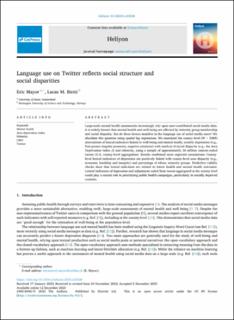| dc.contributor.author | Mayor, Eric | |
| dc.contributor.author | Bietti, Lucas Manuel | |
| dc.date.accessioned | 2024-03-20T11:44:07Z | |
| dc.date.available | 2024-03-20T11:44:07Z | |
| dc.date.created | 2023-12-16T12:37:35Z | |
| dc.date.issued | 2023 | |
| dc.identifier.citation | Heliyon Volume 10, Issue 2 | en_US |
| dc.identifier.issn | 2405-8440 | |
| dc.identifier.uri | https://hdl.handle.net/11250/3123365 | |
| dc.description.abstract | Large-scale mental health assessments increasingly rely upon user-contributed social media data. It is widely known that mental health and well-being are affected by minority group membership and social disparity. But do these factors manifest in the language use of social media users? We elucidate this question using spatial lag regressions. We examined the county-level (N = 1069) associations of lexical indicators linked to well-being and mental health, notably depression (e.g., first-person singular pronouns, negative emotions) with markers of social disparity (e.g., the Area Deprivation Index–3) and ethnicity, using a sample of approximately 30 million content-coded tweets (U.S. county-level aggregation). Results confirmed most expected associations: County-level lexical indicators of depression are positively linked with county-level area disparity (e.g., economic hardship and inequity) and percentage of ethnic minority groups. Predictive validity checks show that lexical indicators are related to future health and mental health outcomes. Lexical indicators of depression and adjustment coded from tweets aggregated at the county level could play a crucial role in prioritizing public health campaigns, particularly in socially deprived counties. | en_US |
| dc.description.abstract | Language use on Twitter reflects social structure and social disparities | en_US |
| dc.language.iso | eng | en_US |
| dc.publisher | Elsevier | en_US |
| dc.rights | Navngivelse 4.0 Internasjonal | * |
| dc.rights.uri | http://creativecommons.org/licenses/by/4.0/deed.no | * |
| dc.title | Language use on Twitter reflects social structure and social disparities | en_US |
| dc.title.alternative | Language use on Twitter reflects social structure and social disparities | en_US |
| dc.type | Journal article | en_US |
| dc.type | Peer reviewed | en_US |
| dc.description.version | publishedVersion | en_US |
| dc.source.journal | Heliyon | en_US |
| dc.identifier.doi | 10.1016/j.heliyon.2023.e23528 | |
| dc.identifier.cristin | 2214436 | |
| cristin.ispublished | true | |
| cristin.fulltext | original | |
| cristin.qualitycode | 1 | |

